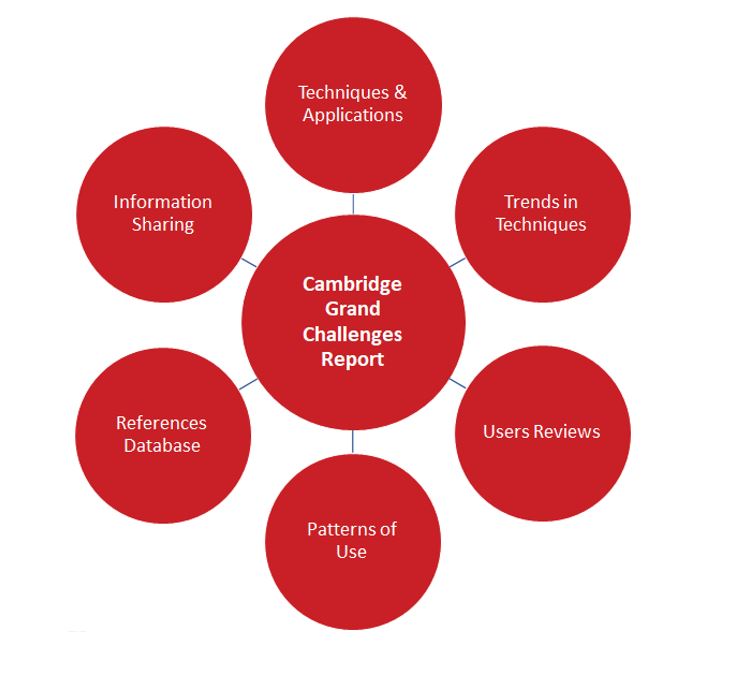Analytik Partners with Cambridge Grand Challenges for 3 Month Study of Trends in Spectroscopy and Imaging for Heritage and Archaeology
As part of its industrial strategy, bringing together PhD students, postdocs and Cambridge academics, Cambridge Grand Challenges (CGC) funds students to spend up to 3 months working on industrial projects with local businesses. These intensive events are dual purpose: to enable researchers to develop skills in stakeholder engagement; and to identify opportunities for future collaboration.
Analytik was pleased to host a project to explore trends in the use of spectroscopy and imaging techniques for heritage and archaeology research with University of Cambridge, Department of Archaeology, PhD candidate Hari Blackmore.
Project Summary
A study of meta-data and survey data was carried out to outline trends and likely future developments in the use of spectroscopy and spectral imaging in UK and Irish heritage and archaeological research papers. Publication meta-data was gathered to investigate broad global trends in the application of various types of spectroscopy and detailed trends in the topics of interest to UK and Ireland based researchers. Surveys of UK and Ireland based researchers and key opinion leaders gathered views on likely future directions, key features of particular instruments, how instruments are shared in collaborations, and through which media key discussions of these techniques principally take place.
Publication trends and surveys focused on particular relevant techniques:

Visible-Near Infrared Spectroscopy (vis-NIR)
- Dramatic increase in heritage science use since 2015 globally, but not sustained within the UK and Ireland. Still, scholars surveyed had a positive outlook that interest will grow in the future
- In heritage, vis-NIR is primarily used to characterise pigments (62% of publications), with the ability to carry out non-destructive analysis in situ a key feature
- Vis-NIR not commonly used in archaeology, but a recent development is the use of the technique to characterise preservation levels in archaeological bone
Fourier Transform Infrared Spectroscopy (FTIR)
- Dramatic increase in heritage science use since 2015 globally, matched in the UK and Ireland. Mixed opinions from the scholars surveyed regarding future scope for growth in FTIR use
- In heritage, FTIR used primarily to investigate pigment chemistry, but also used to track signal of degradation in a variety of materials. Survey respondents highlighted FTIR’s non-destructive analysis and the relative ease of use
- Most common use on archaeology is to characterise bone preservation levels, with the flexibility, ease of use, and relatively low cost emphasised
Raman Spectroscopy
- Dramatic and sustained increase in use since 2015 globally, matched in UK and Ireland heritage science. Majority of respondents had a positive outlook regarding growth in interest, but concerns raised over damage through improper use
- Primary use in heritage science is analysis of pigment chemistry (79% of publications), with the non-invasive nature of analysis highlighted
- Raman not commonly used in archaeology, analysis of pigments most common. Issues concerning damage and the need for a flat surface (rare in archaeology) were raised
X-Ray Fluorescence Spectroscopy (XRF)
- Dramatic and sustained increase in use since 2015 globally, a trend not seen in UK and Ireland. All respondents had a positive outlook regarding sustained growth in interest
- In heritage, analysis of pigment chemistry is the main application (74% of publications), respondents described portability as either “desirable” or “essential”
- Analyses of ceramic or metal composition are the main uses in archaeology (57% of publications), scholars highlighted the non-destructive nature of XRF, along with the importance of portability
Spectral Imaging
- Steady and sustained increase in spectral imaging use since 2010, though much more pronounced in heritage studies, and the outlook from scholars was generally positive
- In heritage, analysis or mapping of pigments is the primary application (58% of publications), with the non-destructive and broader range of information offered being key points
- In archaeology, use in aerial survey was almost exclusive (13 of 14 applications), with the ability to “see the unseen” essential, although work remains experimental
The majority of survey respondents had access to the relevant equipment from their home laboratories or home institutions. Equipment sharing came mostly through cross- or inter-disciplinary projects.
Papers and conferences were highlighted as the primary avenues through which discussions of these techniques take place; however, respondents working in or with heritage institutions noted that a great deal of work and fruitful discussion takes place informally or remains unpublished.
Author Profile
Hari Blackmore is a PhD candidate at the University of Cambridge, Department of Archaeology; he successfully completed his viva voce in December 2019 and is currently making minor corrections for final submission. His thesis examined non-hierarchical social groups and state formation in early 1st millennium Korea, including petrographic and compositional analyses of ceramics to investigate issues of production organisation and exchange. He also trained in applying X-Ray Fluorescence spectroscopy to archaeological ceramics in preparation for his doctoral research.
About Cambridge Grand Challenges
The Cambridge Grand Challenges (CGC) is a framework for collaboration between industry, government, and academia designed to help deliver the Industrial Strategy. CGC brings together industry, PhD students, postdocs and Cambridge academics, and applies relevant social science research and methods to solve pertinent industrial issues. For more information, please visit: https://www.esrcdtp.group.cam.ac.uk/external-engagement/ways-to-engage/cambridge-grand-challenges


